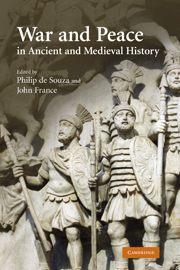Book contents
- Frontmatter
- Contents
- List of contributors
- Acknowledgements
- Note on abbreviations
- 1 Introduction
- 2 Making and breaking treaties in the Greek world
- 3 War, peace and diplomacy in Graeco-Persian relations from the sixth to the fourth century bc
- 4 Treaties, allies and the Roman conquest of Italy
- 5 Parta victoriis pax: Roman emperors as peacemakers
- 6 Treaty-making in Late Antiquity
- 7 Byzantine diplomacy: good faith, trust and co-operation in international relations in Late Antiquity
- 8 Treaties between Byzantium and the Islamic world
- 9 Siege conventions in Western Europe and the Latin East
- 10 Paying the Danegeld: Anglo-Saxon peacemaking with vikings
- 11 Peace among equals: war and treaties in twelfth-century Europe
- Bibliography
- Index
2 - Making and breaking treaties in the Greek world
Published online by Cambridge University Press: 09 August 2009
- Frontmatter
- Contents
- List of contributors
- Acknowledgements
- Note on abbreviations
- 1 Introduction
- 2 Making and breaking treaties in the Greek world
- 3 War, peace and diplomacy in Graeco-Persian relations from the sixth to the fourth century bc
- 4 Treaties, allies and the Roman conquest of Italy
- 5 Parta victoriis pax: Roman emperors as peacemakers
- 6 Treaty-making in Late Antiquity
- 7 Byzantine diplomacy: good faith, trust and co-operation in international relations in Late Antiquity
- 8 Treaties between Byzantium and the Islamic world
- 9 Siege conventions in Western Europe and the Latin East
- 10 Paying the Danegeld: Anglo-Saxon peacemaking with vikings
- 11 Peace among equals: war and treaties in twelfth-century Europe
- Bibliography
- Index
Summary
In this book we are concerned with various aspects of the making and breaking of peace treaties. I concentrate here on various kinds of ambiguity with regard to treaties in the Greek world – concerning the extent to which the participants could choose to decide what actions counted as a breach of a treaty, and whether the breach was so blatant that the treaty could then be considered to be at an end; and concerning the use, whether innocent or deliberate, of ambiguous language that required interpretation in particular cases, where a state in a strong position might try to impose an interpretation that other states might consider unjustified.
I begin with a striking instance of Athens' deciding that an ally had broken his treaty with Athens, declaring that treaty to be at an end, and instead making an alliance with his opponent. In the 360s Athens was allied to Alexander, the tyrant of Pherae in south-eastern Thessaly, while Thebes supported the Thessalian koinon, i.e. the league of Thessalians opposed to Alexander. However, at the end of the 360s Alexander was defeated by Thebes, and, restricted on the mainland, turned to naval action against Athens. In 361/0 Athens reacted by making an alliance for all time with the koinon, and we have the text that was inscribed on stone in Athens.
- Type
- Chapter
- Information
- War and Peace in Ancient and Medieval History , pp. 6 - 27Publisher: Cambridge University PressPrint publication year: 2008
- 7
- Cited by



